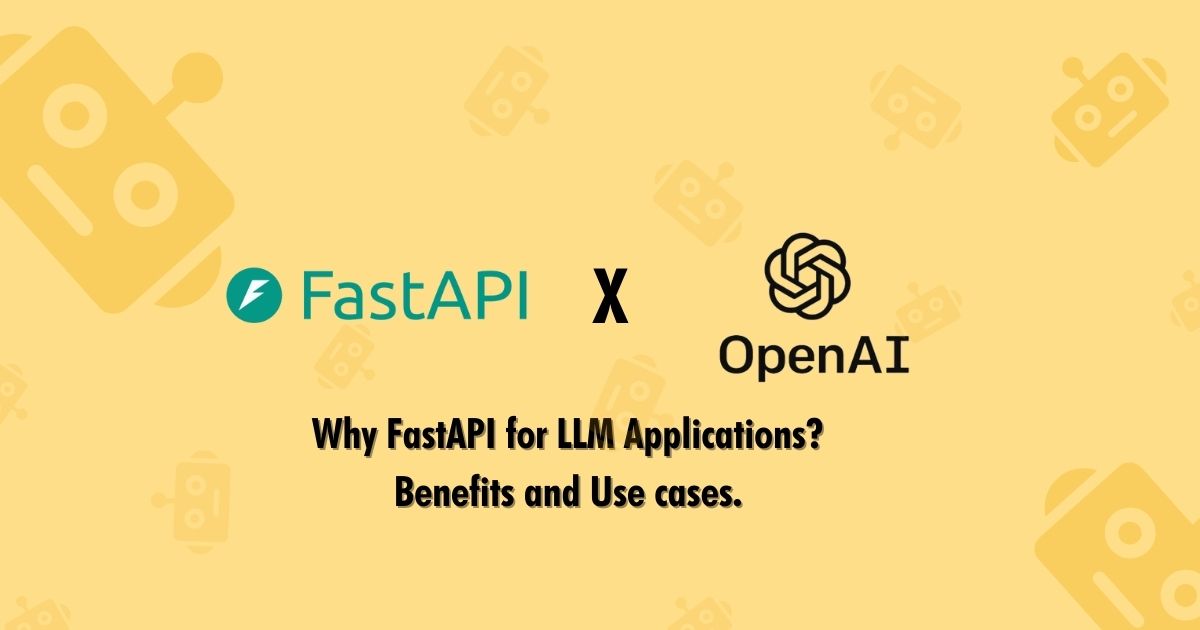What is FastAPI and its LLM Applications?

This blog explores the basics of FastAPI, its core features, and how it’s being applied in the context of LLMs, offering insights into why it has become the framework of choice for many AI and ML practitioners.
In recent years, web frameworks have evolved rapidly to meet the demands of modern applications, providing developers with more efficient, scalable, and user-friendly solutions. One such framework that has gained widespread popularity is FastAPI. Known for its exceptional performance, FastAPI is a modern web framework that has revolutionized how developers build APIs and applications. But beyond its web framework functionality, FastAPI has found its way into the rapidly growing world of Large Language Models (LLMs) and AI-driven applications.
Introduction to FastAPI
FastAPI is a high-performance, Python-based web framework that allows developers to build APIs quickly, with a strong focus on speed and ease of use. It is particularly well-suited for creating RESTful APIs but can be used for any kind of web application.
Here’s why FastAPI stands out:
1. Speed: FastAPI is one of the fastest Python frameworks, thanks to its support for asynchronous programming (using async and await), which makes handling large-scale web requests more efficient.
2. Ease of Use: The framework is designed with developer experience in mind. It provides automatic interactive documentation using OpenAPI and JSON Schema, allowing developers to easily understand and test their APIs.
3. Automatic Validation: FastAPI handles data validation automatically through Python type hints, reducing boilerplate code and increasing productivity.
4. Scalability: Its design principles make it scalable and efficient for applications that need to handle a high number of requests, making it ideal for large-scale systems like AI and LLM-based applications.
Before diving into how FastAPI is used with LLMs, let's explore its fundamental features and why it's become such a game-changer.
Checkout document on deploying LLM application using Docker.
Core Features of FastAPI
1. Asynchronous Programming
FastAPI is built on Python’s asynchronous capabilities (async and await), which allows it to handle concurrent requests without blocking operations. This makes it incredibly efficient for high-performance applications, including those that require real-time responses, such as chatbots or AI-driven platforms.
Concurrency Support: FastAPI can handle hundreds of thousands of requests concurrently without significant performance degradation.Non-blocking I/O: Thanks to asynchronous programming, FastAPI ensures non-blocking I/O operations, leading to better resource management, especially when dealing with I/O-bound tasks such as database queries or API calls.
2. Type Hints for Automatic Validation
One of the key innovations in FastAPI is its use of Python type hints to automatically validate incoming data. For example, if an API endpoint expects an integer, FastAPI will automatically reject any request that does not conform to that type.
Automatic Validation: FastAPI uses thePydanticlibrary for automatic validation of request data. This minimizes the amount of code developers need to write for input validation and error handling.Better Code Readability: Using type hints makes the code more readable, which is particularly useful when collaborating with teams on complex AI models or LLM-driven applications.
3. Interactive API Documentation
FastAPI automatically generates interactive API documentation using Swagger UI and ReDoc. This feature allows developers to test and explore the API endpoints in real time, making debugging and understanding API behavior much easier.
Swagger UI: Provides a user-friendly interface for interacting with the API, allowing developers to send test requests and view responses.ReDoc: Offers another documentation interface that provides a detailed overview of the API structure, types, and models.
4. Dependency Injection System
FastAPI includes a powerful dependency injection system, which allows you to structure your code more efficiently by injecting dependencies like database sessions, authentication mechanisms, or background tasks. This leads to cleaner and more modular code.
Easy Management of Resources: By using the dependency injection system, developers can easily manage resources such as database connections, authentication middleware, or caching layers.Improved Testability: With dependency injection, testing becomes much easier because dependencies can be mocked or swapped during unit tests.
FastAPI in Machine Learning and LLM Applications
FastAPI’s high performance and scalability make it a perfect choice for machine learning (ML) and Large Language Model (LLM) applications. As LLMs like GPT-3, GPT-4, BERT, and others become integral to many industries, deploying these models efficiently and reliably requires a fast, robust backend. FastAPI offers the right blend of performance, ease of deployment, and features to support the real-time needs of LLM applications.
1. Serving LLMs via API Endpoints
A typical use case for FastAPI in LLM applications is serving models via API endpoints. Instead of running models locally, which may be resource-intensive, developers can deploy an LLM on a server and expose its functionalities through FastAPI.
LLM as a Service: Developers can create APIs that expose the model's capabilities (e.g., text completion, summarization, translation) as a service. Clients can send HTTP requests to the FastAPI endpoints, passing text inputs, and receiving predictions or results from the LLM.Scaling for High Traffic: Since LLM applications often experience high traffic, particularly in production environments, FastAPI’s asynchronous nature makes it an ideal choice for handling a large volume of API requests with minimal latency.
Example:
from fastapi import FastAPI
from transformers import pipeline
app = FastAPI()
# Load a pre-trained transformer model for text completion
model = pipeline("text-generation", model="gpt2")
@app.post("/generate/")
async def generate_text(prompt: str):
result = model(prompt, max_length=50, num_return_sequences=1)
return {"generated_text": result[0]['generated_text']}
In this example, FastAPI is used to deploy a pre-trained GPT-2 model, enabling clients to send a prompt and receive a generated text response from the model.
2. Real-Time Text Processing
FastAPI’s low-latency capabilities make it ideal for real-time text processing tasks, such as sentiment analysis, entity recognition, or machine translation, all of which are commonly powered by LLMs. These tasks often require near-instant responses, particularly in applications like chatbots or virtual assistants.
Chatbot Applications: Chatbots driven by LLMs can leverage FastAPI to process user queries in real time. The asynchronous nature of FastAPI ensures that the response times are kept low, enhancing the user experience.Interactive AI Systems: LLMs used in interactive systems like customer support or virtual assistants can use FastAPI to process user inputs quickly, deliver responses, and handle multiple concurrent conversations seamlessly.
3. Model Deployment and Inference
One of the biggest challenges in ML and LLM applications is deploying trained models to production environments. FastAPI makes this process more manageable by allowing developers to create RESTful APIs that serve model inference results.
Model Inference API: With FastAPI, models trained in frameworks like TensorFlow, PyTorch, or Hugging Face can be easily integrated into web applications. FastAPI allows developers to create inference endpoints where users can input data and receive model predictions in real time.Efficient Inference: FastAPI can handle batch processing and streaming data, making it suitable for real-time model inference. This is particularly important for LLM applications that may need to process large volumes of text or make predictions on streaming data.
Example of Serving a BERT Model for Text Classification:
from fastapi import FastAPI
from transformers import pipeline
app = FastAPI()
# Load a pre-trained BERT model for sentiment analysis
sentiment_analyzer = pipeline("sentiment-analysis")
@app.post("/sentiment/")
async def sentiment_analysis(text: str):
result = sentiment_analyzer(text)
return {"label": result[0]['label'], "score": result[0]['score']}
In this example, FastAPI serves a BERT-based sentiment analysis model. Users can send text input and receive sentiment predictions (positive or negative) with a confidence score.
4. Batch Processing for LLM Applications
LLM applications often require batch processing, especially when dealing with large datasets or when performing inference on multiple inputs. FastAPI's ability to handle batch requests efficiently helps reduce processing time.
Asynchronous Batch Processing: FastAPI can process multiple requests concurrently, making it ideal for batch processing tasks. This capability is particularly useful in scenarios where multiple inputs need to be processed simultaneously, such as document classification or large-scale text summarization.Parallel Inference: FastAPI's asynchronous support allows for parallel inference, enabling faster processing times when deploying LLMs for large-scale applications.
Why FastAPI for LLM Applications?
FastAPI's advantages for LLM applications stem from its high performance, ease of use, and scalability. Below are some key reasons why FastAPI is particularly well-suited for LLM-driven applications:
1. High Throughput and Low Latency: LLM applications often require real-time or near-real-time responses, particularly in conversational AI systems. FastAPI’s asynchronous architecture ensures that LLMs can be deployed with minimal response times, making it suitable for high-throughput environments.
2. Asynchronous Task Handling: Many LLM applications need to handle tasks that can be offloaded to background processes, such as text generation or large-scale data analysis. FastAPI allows developers to easily manage background tasks using tools like Celery, ensuring efficient resource usage.
3. Seamless Integration with ML Frameworks: FastAPI integrates smoothly with popular ML and NLP frameworks like Hugging Face Transformers, TensorFlow, and PyTorch. This ease of integration means that developers can quickly serve LLMs via API endpoints without needing to re-architect their systems.
4. Extensibility for Microservices: FastAPI is an excellent choice for deploying microservices. When LLM applications need to be broken down into smaller, independent services (e.g., one service for text generation, another for sentiment analysis), FastAPI’s lightweight and modular nature make it easy to develop and maintain such systems.
5. Interactive Documentation: For LLM applications, the automatic generation of API documentation can be invaluable, especially when sharing your API with other teams or developers. FastAPI's interactive Swagger and ReDoc interfaces simplify the process of API testing and iteration.
FastAPI for LLM Applications: Use Cases
Now that we understand the benefits of FastAPI for LLM applications, let’s explore some practical use cases where it shines:
1. Real-Time Conversational Agents (Chatbots) LLM-driven chatbots are increasingly being used in customer service, virtual assistants, and helpdesk solutions. FastAPI can serve as the backend framework that handles natural language inputs, processes them using an LLM like GPT-3, and delivers responses in real time.
2. Automated Content Generation With the rise of content marketing and personalization, many companies are leveraging LLMs to generate blog posts, social media content, and more. FastAPI can handle requests to generate content based on given topics, keywords, or outlines, providing an efficient pipeline for automated content creation.
3. Sentiment and Emotion Analysis LLMs trained for sentiment and emotion detection are widely used in social media monitoring, customer feedback analysis, and brand reputation management. FastAPI can power APIs that process text data (tweets, reviews, etc.) and deliver insights into public sentiment.
4. Text Summarization and Translation Services FastAPI is an excellent choice for hosting APIs that provide text summarization and translation services, powered by LLMs like BART or T5. These services can be utilized in industries like legal, healthcare, and journalism to quickly distill large volumes of text or translate content into different languages.
Conclusion
FastAPI has emerged as a leading framework for developing high-performance, scalable APIs, and its synergy with Large Language Models (LLMs) opens up a world of possibilities in AI-driven applications. Its asynchronous capabilities, ease of use, and seamless integration with popular machine learning libraries make it the ideal choice for deploying LLMs in production environments.
Whether you're building a real-time chatbot, automating content generation, or providing advanced text analysis services, FastAPI’s ability to handle large-scale requests with low latency makes it a go-to framework for LLM-powered applications.
